CHCDIV002 Promote ATSI Cultural Safety: Nursing Diploma Task 1
VerifiedAdded on 2023/06/17
|6
|2538
|125
Homework Assignment
AI Summary
This document presents a student's answers to an assessment task focused on promoting Aboriginal and Torres Strait Islander (ATSI) cultural safety within a healthcare context. The assessment, likely part of a Diploma of Nursing program, covers key concepts such as defining culturally safe healthcare environments, the importance of cultural awareness and competence, and the benefits of culturally specific clinics. It explores how mainstream services can better cater to ATSI patients, potential negative experiences faced by ATSI individuals in non-culturally competent settings, and tangible indicators of culturally safe services. Furthermore, it delves into the role of the health performance framework in supporting ATSI health, the significance of self-determination in patient care, and the impact of cultural bias in healthcare interactions. The assessment concludes with practical examples of how to ensure inclusivity of all cultures in healthcare settings and reflects on personal cultural influences in professional interactions. Desklib provides a platform for students to access this and similar resources.
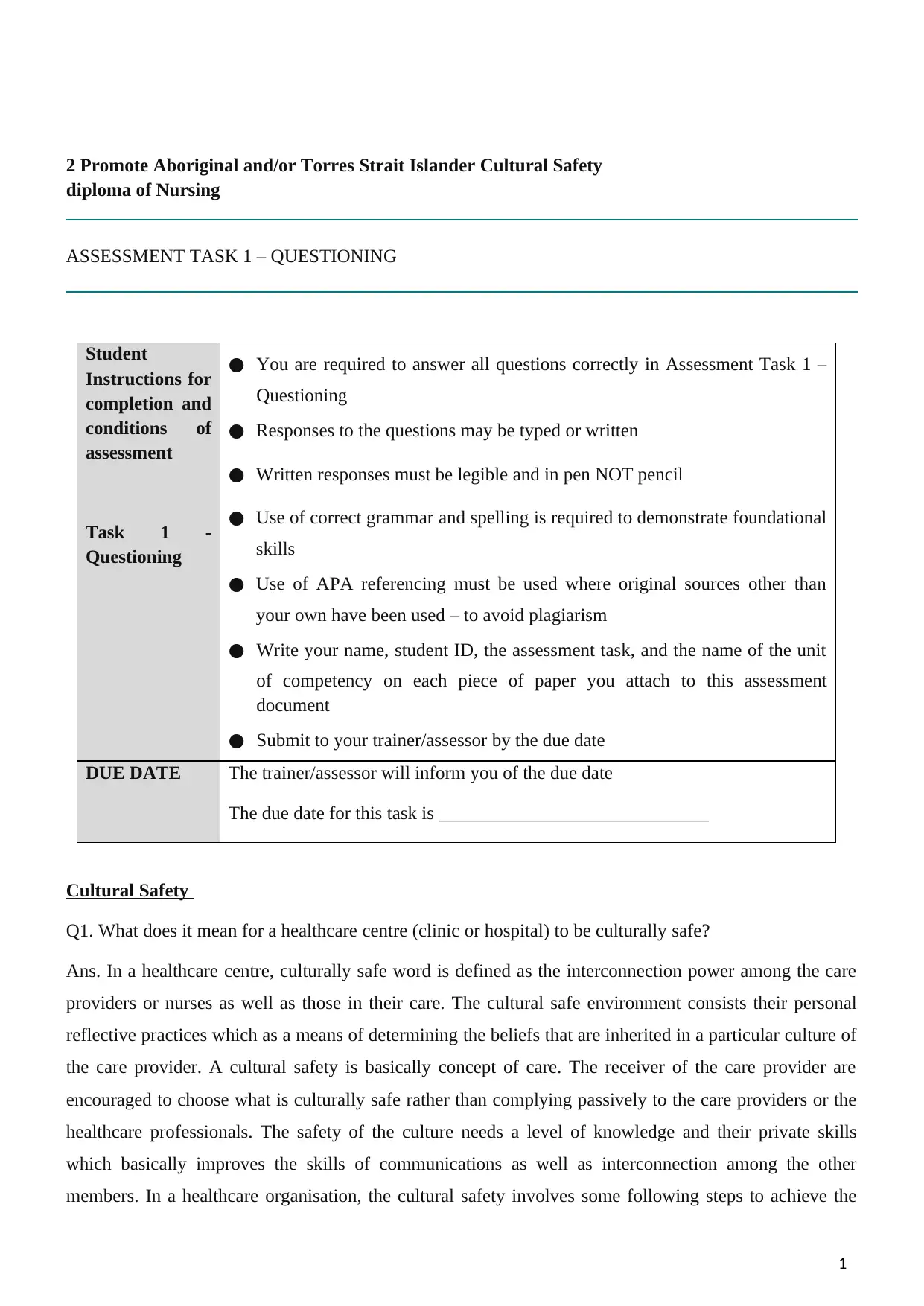
2 Promote Aboriginal and/or Torres Strait Islander Cultural Safety
diploma of Nursing
ASSESSMENT TASK 1 – QUESTIONING
Student
Instructions for
completion and
conditions of
assessment
Task 1 -
Questioning
● You are required to answer all questions correctly in Assessment Task 1 –
Questioning
● Responses to the questions may be typed or written
● Written responses must be legible and in pen NOT pencil
● Use of correct grammar and spelling is required to demonstrate foundational
skills
● Use of APA referencing must be used where original sources other than
your own have been used – to avoid plagiarism
● Write your name, student ID, the assessment task, and the name of the unit
of competency on each piece of paper you attach to this assessment
document
● Submit to your trainer/assessor by the due date
DUE DATE The trainer/assessor will inform you of the due date
The due date for this task is _____________________________
Cultural Safety
Q1. What does it mean for a healthcare centre (clinic or hospital) to be culturally safe?
Ans. In a healthcare centre, culturally safe word is defined as the interconnection power among the care
providers or nurses as well as those in their care. The cultural safe environment consists their personal
reflective practices which as a means of determining the beliefs that are inherited in a particular culture of
the care provider. A cultural safety is basically concept of care. The receiver of the care provider are
encouraged to choose what is culturally safe rather than complying passively to the care providers or the
healthcare professionals. The safety of the culture needs a level of knowledge and their private skills
which basically improves the skills of communications as well as interconnection among the other
members. In a healthcare organisation, the cultural safety involves some following steps to achieve the
1
diploma of Nursing
ASSESSMENT TASK 1 – QUESTIONING
Student
Instructions for
completion and
conditions of
assessment
Task 1 -
Questioning
● You are required to answer all questions correctly in Assessment Task 1 –
Questioning
● Responses to the questions may be typed or written
● Written responses must be legible and in pen NOT pencil
● Use of correct grammar and spelling is required to demonstrate foundational
skills
● Use of APA referencing must be used where original sources other than
your own have been used – to avoid plagiarism
● Write your name, student ID, the assessment task, and the name of the unit
of competency on each piece of paper you attach to this assessment
document
● Submit to your trainer/assessor by the due date
DUE DATE The trainer/assessor will inform you of the due date
The due date for this task is _____________________________
Cultural Safety
Q1. What does it mean for a healthcare centre (clinic or hospital) to be culturally safe?
Ans. In a healthcare centre, culturally safe word is defined as the interconnection power among the care
providers or nurses as well as those in their care. The cultural safe environment consists their personal
reflective practices which as a means of determining the beliefs that are inherited in a particular culture of
the care provider. A cultural safety is basically concept of care. The receiver of the care provider are
encouraged to choose what is culturally safe rather than complying passively to the care providers or the
healthcare professionals. The safety of the culture needs a level of knowledge and their private skills
which basically improves the skills of communications as well as interconnection among the other
members. In a healthcare organisation, the cultural safety involves some following steps to achieve the
1
Paraphrase This Document
Need a fresh take? Get an instant paraphrase of this document with our AI Paraphraser
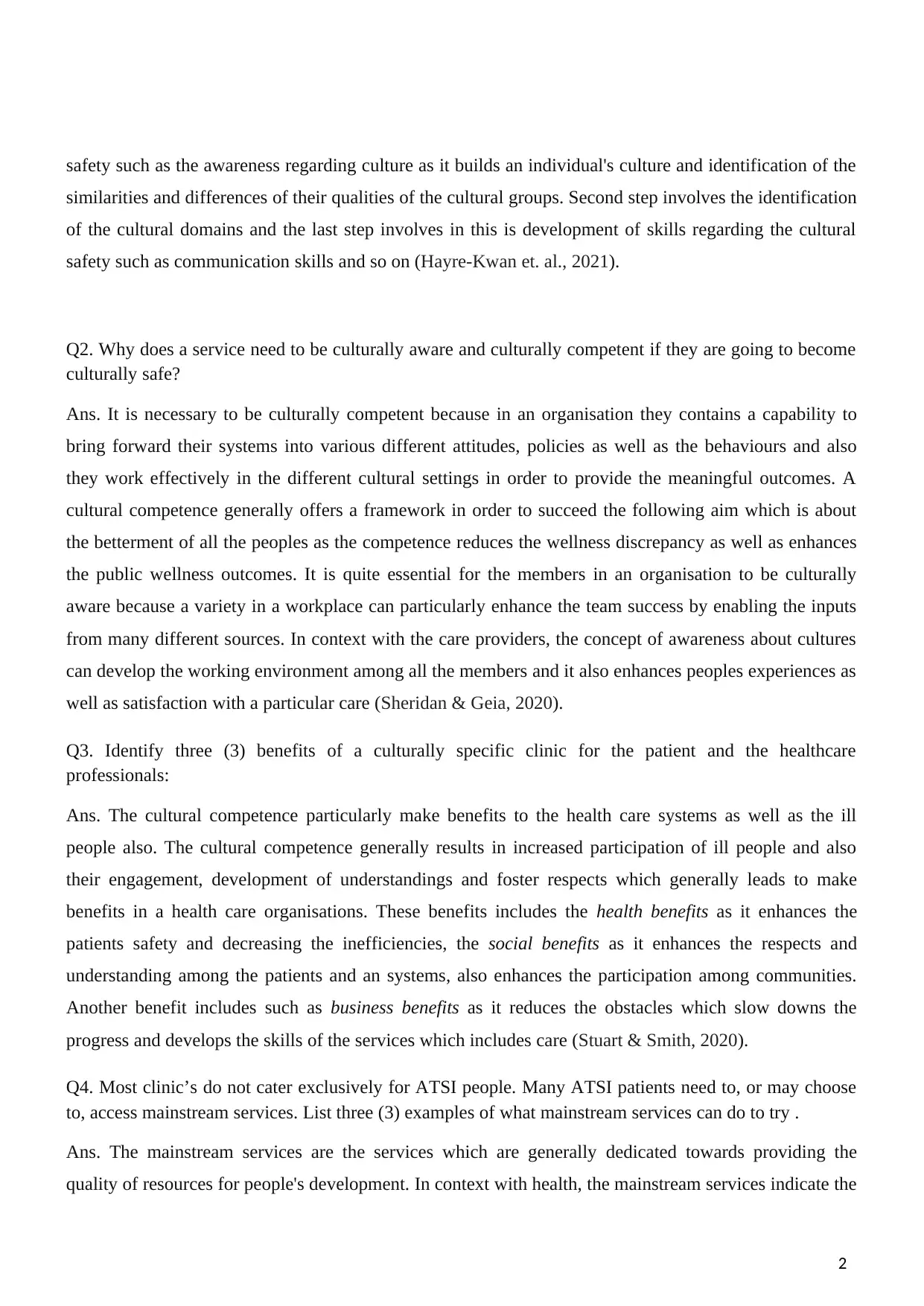
safety such as the awareness regarding culture as it builds an individual's culture and identification of the
similarities and differences of their qualities of the cultural groups. Second step involves the identification
of the cultural domains and the last step involves in this is development of skills regarding the cultural
safety such as communication skills and so on (Hayre-Kwan et. al., 2021).
Q2. Why does a service need to be culturally aware and culturally competent if they are going to become
culturally safe?
Ans. It is necessary to be culturally competent because in an organisation they contains a capability to
bring forward their systems into various different attitudes, policies as well as the behaviours and also
they work effectively in the different cultural settings in order to provide the meaningful outcomes. A
cultural competence generally offers a framework in order to succeed the following aim which is about
the betterment of all the peoples as the competence reduces the wellness discrepancy as well as enhances
the public wellness outcomes. It is quite essential for the members in an organisation to be culturally
aware because a variety in a workplace can particularly enhance the team success by enabling the inputs
from many different sources. In context with the care providers, the concept of awareness about cultures
can develop the working environment among all the members and it also enhances peoples experiences as
well as satisfaction with a particular care (Sheridan & Geia, 2020).
Q3. Identify three (3) benefits of a culturally specific clinic for the patient and the healthcare
professionals:
Ans. The cultural competence particularly make benefits to the health care systems as well as the ill
people also. The cultural competence generally results in increased participation of ill people and also
their engagement, development of understandings and foster respects which generally leads to make
benefits in a health care organisations. These benefits includes the health benefits as it enhances the
patients safety and decreasing the inefficiencies, the social benefits as it enhances the respects and
understanding among the patients and an systems, also enhances the participation among communities.
Another benefit includes such as business benefits as it reduces the obstacles which slow downs the
progress and develops the skills of the services which includes care (Stuart & Smith, 2020).
Q4. Most clinic’s do not cater exclusively for ATSI people. Many ATSI patients need to, or may choose
to, access mainstream services. List three (3) examples of what mainstream services can do to try .
Ans. The mainstream services are the services which are generally dedicated towards providing the
quality of resources for people's development. In context with health, the mainstream services indicate the
2
similarities and differences of their qualities of the cultural groups. Second step involves the identification
of the cultural domains and the last step involves in this is development of skills regarding the cultural
safety such as communication skills and so on (Hayre-Kwan et. al., 2021).
Q2. Why does a service need to be culturally aware and culturally competent if they are going to become
culturally safe?
Ans. It is necessary to be culturally competent because in an organisation they contains a capability to
bring forward their systems into various different attitudes, policies as well as the behaviours and also
they work effectively in the different cultural settings in order to provide the meaningful outcomes. A
cultural competence generally offers a framework in order to succeed the following aim which is about
the betterment of all the peoples as the competence reduces the wellness discrepancy as well as enhances
the public wellness outcomes. It is quite essential for the members in an organisation to be culturally
aware because a variety in a workplace can particularly enhance the team success by enabling the inputs
from many different sources. In context with the care providers, the concept of awareness about cultures
can develop the working environment among all the members and it also enhances peoples experiences as
well as satisfaction with a particular care (Sheridan & Geia, 2020).
Q3. Identify three (3) benefits of a culturally specific clinic for the patient and the healthcare
professionals:
Ans. The cultural competence particularly make benefits to the health care systems as well as the ill
people also. The cultural competence generally results in increased participation of ill people and also
their engagement, development of understandings and foster respects which generally leads to make
benefits in a health care organisations. These benefits includes the health benefits as it enhances the
patients safety and decreasing the inefficiencies, the social benefits as it enhances the respects and
understanding among the patients and an systems, also enhances the participation among communities.
Another benefit includes such as business benefits as it reduces the obstacles which slow downs the
progress and develops the skills of the services which includes care (Stuart & Smith, 2020).
Q4. Most clinic’s do not cater exclusively for ATSI people. Many ATSI patients need to, or may choose
to, access mainstream services. List three (3) examples of what mainstream services can do to try .
Ans. The mainstream services are the services which are generally dedicated towards providing the
quality of resources for people's development. In context with health, the mainstream services indicate the
2
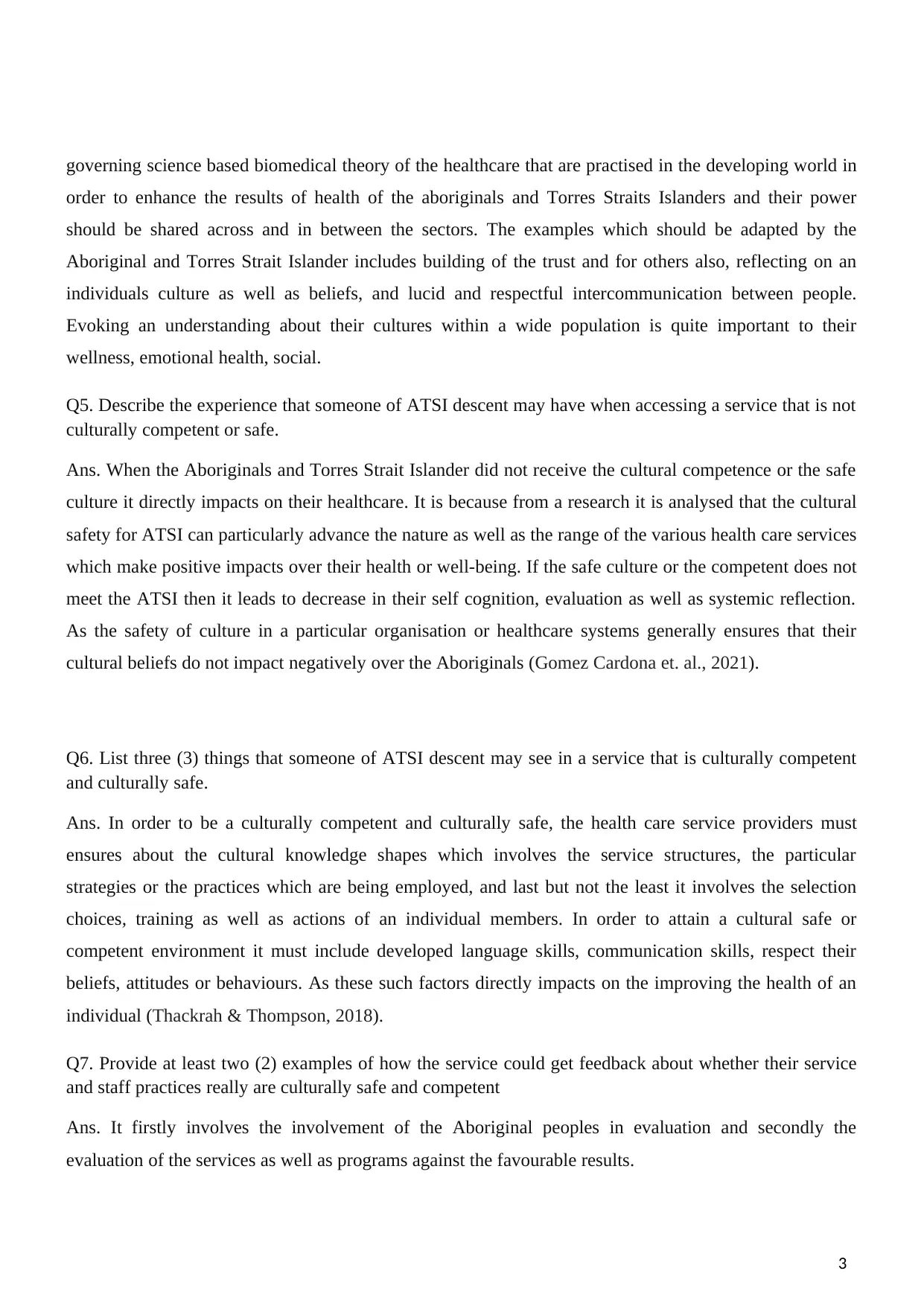
governing science based biomedical theory of the healthcare that are practised in the developing world in
order to enhance the results of health of the aboriginals and Torres Straits Islanders and their power
should be shared across and in between the sectors. The examples which should be adapted by the
Aboriginal and Torres Strait Islander includes building of the trust and for others also, reflecting on an
individuals culture as well as beliefs, and lucid and respectful intercommunication between people.
Evoking an understanding about their cultures within a wide population is quite important to their
wellness, emotional health, social.
Q5. Describe the experience that someone of ATSI descent may have when accessing a service that is not
culturally competent or safe.
Ans. When the Aboriginals and Torres Strait Islander did not receive the cultural competence or the safe
culture it directly impacts on their healthcare. It is because from a research it is analysed that the cultural
safety for ATSI can particularly advance the nature as well as the range of the various health care services
which make positive impacts over their health or well-being. If the safe culture or the competent does not
meet the ATSI then it leads to decrease in their self cognition, evaluation as well as systemic reflection.
As the safety of culture in a particular organisation or healthcare systems generally ensures that their
cultural beliefs do not impact negatively over the Aboriginals (Gomez Cardona et. al., 2021).
Q6. List three (3) things that someone of ATSI descent may see in a service that is culturally competent
and culturally safe.
Ans. In order to be a culturally competent and culturally safe, the health care service providers must
ensures about the cultural knowledge shapes which involves the service structures, the particular
strategies or the practices which are being employed, and last but not the least it involves the selection
choices, training as well as actions of an individual members. In order to attain a cultural safe or
competent environment it must include developed language skills, communication skills, respect their
beliefs, attitudes or behaviours. As these such factors directly impacts on the improving the health of an
individual (Thackrah & Thompson, 2018).
Q7. Provide at least two (2) examples of how the service could get feedback about whether their service
and staff practices really are culturally safe and competent
Ans. It firstly involves the involvement of the Aboriginal peoples in evaluation and secondly the
evaluation of the services as well as programs against the favourable results.
3
order to enhance the results of health of the aboriginals and Torres Straits Islanders and their power
should be shared across and in between the sectors. The examples which should be adapted by the
Aboriginal and Torres Strait Islander includes building of the trust and for others also, reflecting on an
individuals culture as well as beliefs, and lucid and respectful intercommunication between people.
Evoking an understanding about their cultures within a wide population is quite important to their
wellness, emotional health, social.
Q5. Describe the experience that someone of ATSI descent may have when accessing a service that is not
culturally competent or safe.
Ans. When the Aboriginals and Torres Strait Islander did not receive the cultural competence or the safe
culture it directly impacts on their healthcare. It is because from a research it is analysed that the cultural
safety for ATSI can particularly advance the nature as well as the range of the various health care services
which make positive impacts over their health or well-being. If the safe culture or the competent does not
meet the ATSI then it leads to decrease in their self cognition, evaluation as well as systemic reflection.
As the safety of culture in a particular organisation or healthcare systems generally ensures that their
cultural beliefs do not impact negatively over the Aboriginals (Gomez Cardona et. al., 2021).
Q6. List three (3) things that someone of ATSI descent may see in a service that is culturally competent
and culturally safe.
Ans. In order to be a culturally competent and culturally safe, the health care service providers must
ensures about the cultural knowledge shapes which involves the service structures, the particular
strategies or the practices which are being employed, and last but not the least it involves the selection
choices, training as well as actions of an individual members. In order to attain a cultural safe or
competent environment it must include developed language skills, communication skills, respect their
beliefs, attitudes or behaviours. As these such factors directly impacts on the improving the health of an
individual (Thackrah & Thompson, 2018).
Q7. Provide at least two (2) examples of how the service could get feedback about whether their service
and staff practices really are culturally safe and competent
Ans. It firstly involves the involvement of the Aboriginal peoples in evaluation and secondly the
evaluation of the services as well as programs against the favourable results.
3
⊘ This is a preview!⊘
Do you want full access?
Subscribe today to unlock all pages.

Trusted by 1+ million students worldwide
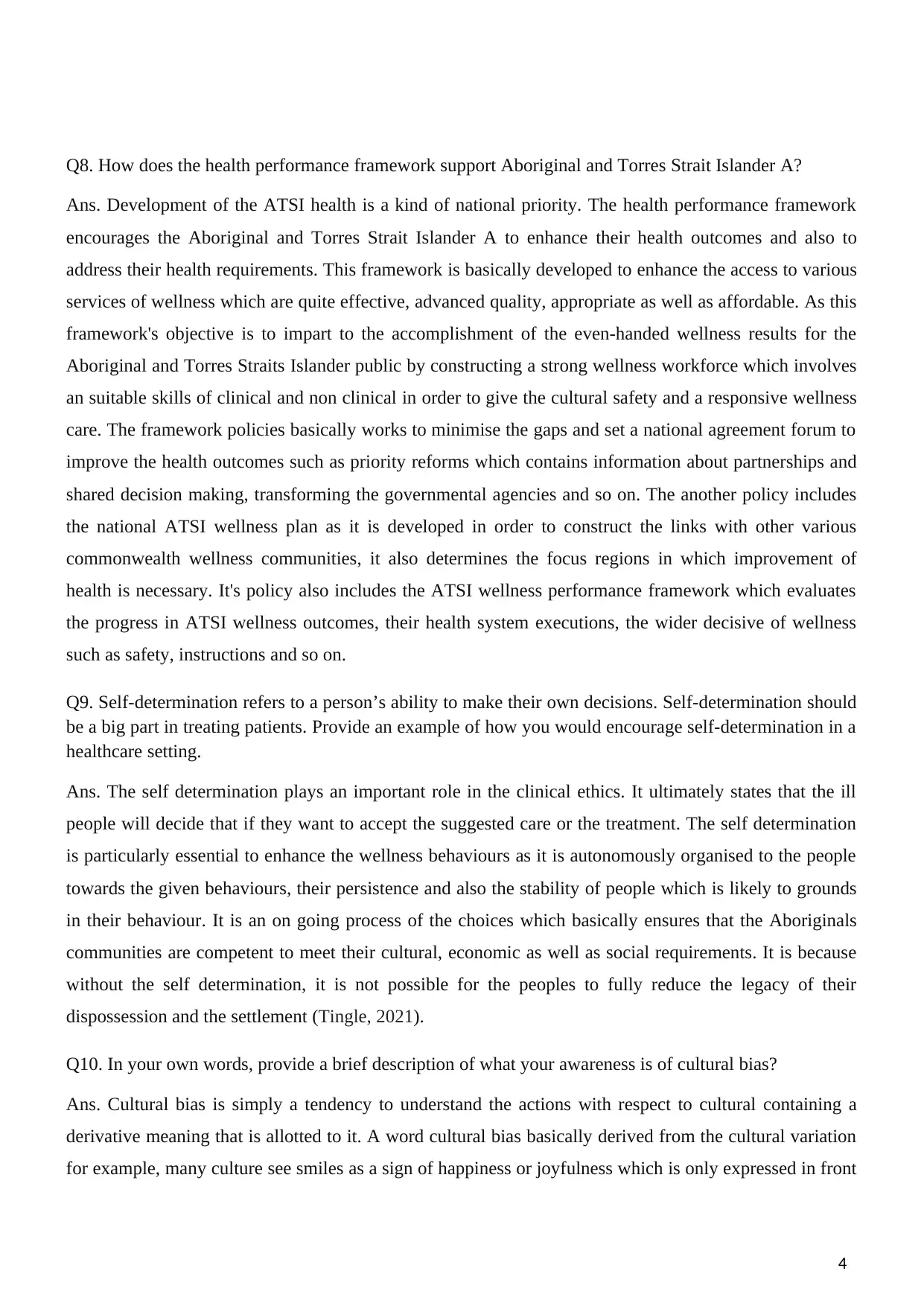
Q8. How does the health performance framework support Aboriginal and Torres Strait Islander A?
Ans. Development of the ATSI health is a kind of national priority. The health performance framework
encourages the Aboriginal and Torres Strait Islander A to enhance their health outcomes and also to
address their health requirements. This framework is basically developed to enhance the access to various
services of wellness which are quite effective, advanced quality, appropriate as well as affordable. As this
framework's objective is to impart to the accomplishment of the even-handed wellness results for the
Aboriginal and Torres Straits Islander public by constructing a strong wellness workforce which involves
an suitable skills of clinical and non clinical in order to give the cultural safety and a responsive wellness
care. The framework policies basically works to minimise the gaps and set a national agreement forum to
improve the health outcomes such as priority reforms which contains information about partnerships and
shared decision making, transforming the governmental agencies and so on. The another policy includes
the national ATSI wellness plan as it is developed in order to construct the links with other various
commonwealth wellness communities, it also determines the focus regions in which improvement of
health is necessary. It's policy also includes the ATSI wellness performance framework which evaluates
the progress in ATSI wellness outcomes, their health system executions, the wider decisive of wellness
such as safety, instructions and so on.
Q9. Self-determination refers to a person’s ability to make their own decisions. Self-determination should
be a big part in treating patients. Provide an example of how you would encourage self-determination in a
healthcare setting.
Ans. The self determination plays an important role in the clinical ethics. It ultimately states that the ill
people will decide that if they want to accept the suggested care or the treatment. The self determination
is particularly essential to enhance the wellness behaviours as it is autonomously organised to the people
towards the given behaviours, their persistence and also the stability of people which is likely to grounds
in their behaviour. It is an on going process of the choices which basically ensures that the Aboriginals
communities are competent to meet their cultural, economic as well as social requirements. It is because
without the self determination, it is not possible for the peoples to fully reduce the legacy of their
dispossession and the settlement (Tingle, 2021).
Q10. In your own words, provide a brief description of what your awareness is of cultural bias?
Ans. Cultural bias is simply a tendency to understand the actions with respect to cultural containing a
derivative meaning that is allotted to it. A word cultural bias basically derived from the cultural variation
for example, many culture see smiles as a sign of happiness or joyfulness which is only expressed in front
4
Ans. Development of the ATSI health is a kind of national priority. The health performance framework
encourages the Aboriginal and Torres Strait Islander A to enhance their health outcomes and also to
address their health requirements. This framework is basically developed to enhance the access to various
services of wellness which are quite effective, advanced quality, appropriate as well as affordable. As this
framework's objective is to impart to the accomplishment of the even-handed wellness results for the
Aboriginal and Torres Straits Islander public by constructing a strong wellness workforce which involves
an suitable skills of clinical and non clinical in order to give the cultural safety and a responsive wellness
care. The framework policies basically works to minimise the gaps and set a national agreement forum to
improve the health outcomes such as priority reforms which contains information about partnerships and
shared decision making, transforming the governmental agencies and so on. The another policy includes
the national ATSI wellness plan as it is developed in order to construct the links with other various
commonwealth wellness communities, it also determines the focus regions in which improvement of
health is necessary. It's policy also includes the ATSI wellness performance framework which evaluates
the progress in ATSI wellness outcomes, their health system executions, the wider decisive of wellness
such as safety, instructions and so on.
Q9. Self-determination refers to a person’s ability to make their own decisions. Self-determination should
be a big part in treating patients. Provide an example of how you would encourage self-determination in a
healthcare setting.
Ans. The self determination plays an important role in the clinical ethics. It ultimately states that the ill
people will decide that if they want to accept the suggested care or the treatment. The self determination
is particularly essential to enhance the wellness behaviours as it is autonomously organised to the people
towards the given behaviours, their persistence and also the stability of people which is likely to grounds
in their behaviour. It is an on going process of the choices which basically ensures that the Aboriginals
communities are competent to meet their cultural, economic as well as social requirements. It is because
without the self determination, it is not possible for the peoples to fully reduce the legacy of their
dispossession and the settlement (Tingle, 2021).
Q10. In your own words, provide a brief description of what your awareness is of cultural bias?
Ans. Cultural bias is simply a tendency to understand the actions with respect to cultural containing a
derivative meaning that is allotted to it. A word cultural bias basically derived from the cultural variation
for example, many culture see smiles as a sign of happiness or joyfulness which is only expressed in front
4
Paraphrase This Document
Need a fresh take? Get an instant paraphrase of this document with our AI Paraphraser

of close people. This word simply involves a detailed distinction in a particular viewpoint that usually
propose a bias of one culture over the another culture. As these may involves distinctions in the levels of
religions, language, socio-economic status and so on. It may be explained as discriminative. As it is a
interpretation of the situations or actions or it can be a data based on the regulations of an individuals
culture. It has been identified as constituent which helps in determining where an individual can live or it
also include what an individual can have as an learning and wellness care possibilities.
Q11. An awareness of our cultural bias may lead to a general focus on mostly western cultures, what can
we do, in a healthcare setting, to make sure we are inclusive of all cultures.
Ans. In healthcare systems, to make people inclusive in all the cultures includes the awareness, avoid
making assumptions, educate about the different cultures, construct of trust, decrease the language
obstacles, educate peoTingle2021ple about their wellness settings, exercising about the active listening.
As the increasing diversities of the communities brings the various opportunities as well as the challenges
for the care providers or the systems to create and deliver the services which are culturally competent
(Gibson et. al., 2017).
Q12 Provide an example of a time that your own cultural background and values may have influenced the
way you work or interacted with others? (Indian culture)
Ans. The cultural values or beliefs are naturally a series of principles which can be passed from one
generation to another generation by the ancestors. It does affects the health care also as the religious and
cultural background of elders often impacts over the end of the life care decisions. The people who are
older more likely to subscribe to their family in decision making than being autonomous. It is because
when an individual is very close to their deaths, the family members are more likely to be present in a
large numbers. The respect for cultures is essential to decreasing the health disparities. As it totally
enhances to access to the high level quality care of the health which is basically respectful of or very
respondent to the requirements of the variety of ill people. An Indian culture such as the social and
emotional culture that includes the level of knowledge, the exposure to the violence, the way in which
communities are structured, and the access to healthcare. As these such factors make impact the capability
to take part in the healthy behaviours and thus affect the health of an individual.
5
propose a bias of one culture over the another culture. As these may involves distinctions in the levels of
religions, language, socio-economic status and so on. It may be explained as discriminative. As it is a
interpretation of the situations or actions or it can be a data based on the regulations of an individuals
culture. It has been identified as constituent which helps in determining where an individual can live or it
also include what an individual can have as an learning and wellness care possibilities.
Q11. An awareness of our cultural bias may lead to a general focus on mostly western cultures, what can
we do, in a healthcare setting, to make sure we are inclusive of all cultures.
Ans. In healthcare systems, to make people inclusive in all the cultures includes the awareness, avoid
making assumptions, educate about the different cultures, construct of trust, decrease the language
obstacles, educate peoTingle2021ple about their wellness settings, exercising about the active listening.
As the increasing diversities of the communities brings the various opportunities as well as the challenges
for the care providers or the systems to create and deliver the services which are culturally competent
(Gibson et. al., 2017).
Q12 Provide an example of a time that your own cultural background and values may have influenced the
way you work or interacted with others? (Indian culture)
Ans. The cultural values or beliefs are naturally a series of principles which can be passed from one
generation to another generation by the ancestors. It does affects the health care also as the religious and
cultural background of elders often impacts over the end of the life care decisions. The people who are
older more likely to subscribe to their family in decision making than being autonomous. It is because
when an individual is very close to their deaths, the family members are more likely to be present in a
large numbers. The respect for cultures is essential to decreasing the health disparities. As it totally
enhances to access to the high level quality care of the health which is basically respectful of or very
respondent to the requirements of the variety of ill people. An Indian culture such as the social and
emotional culture that includes the level of knowledge, the exposure to the violence, the way in which
communities are structured, and the access to healthcare. As these such factors make impact the capability
to take part in the healthy behaviours and thus affect the health of an individual.
5
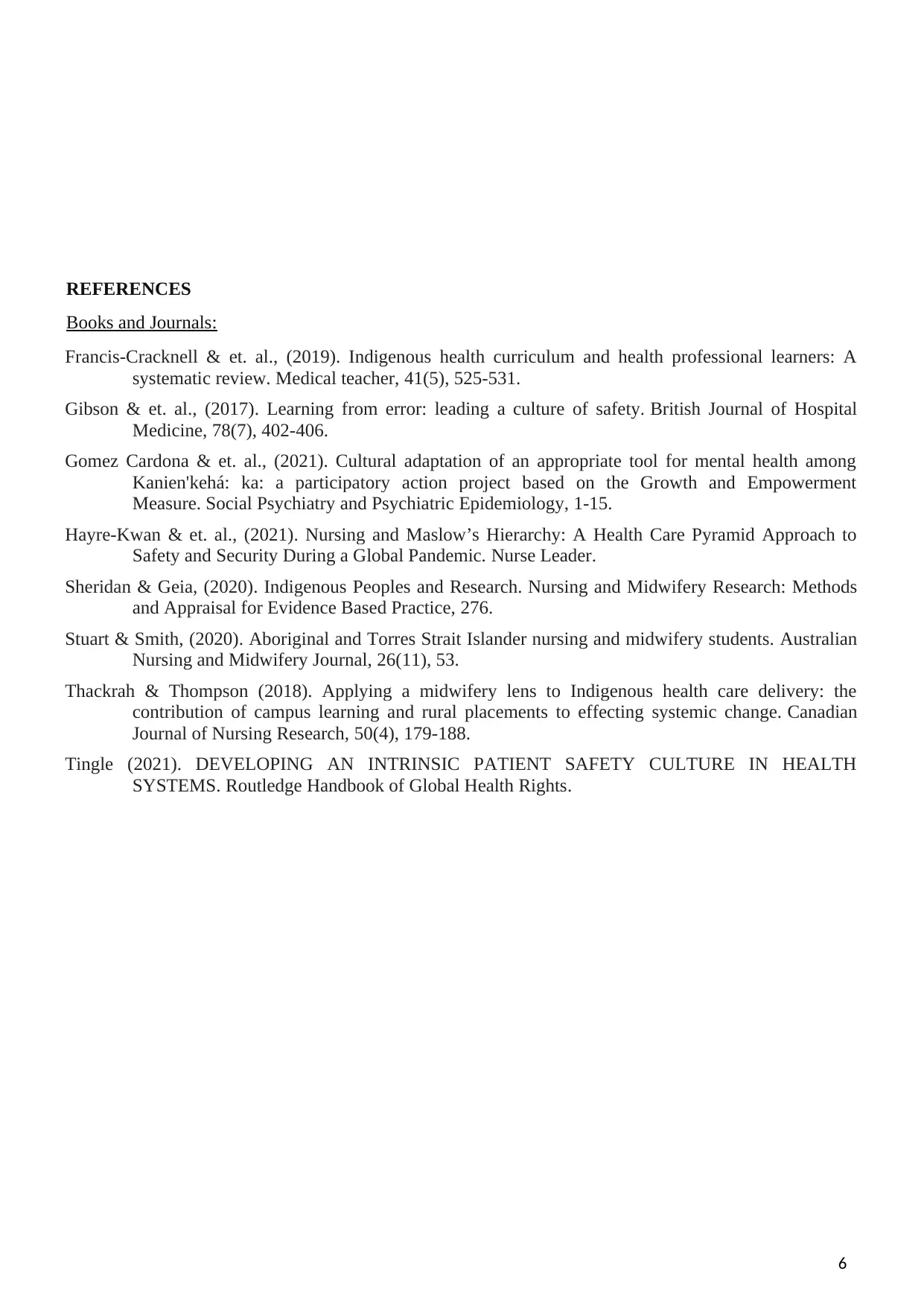
REFERENCES
Books and Journals:
Francis-Cracknell & et. al., (2019). Indigenous health curriculum and health professional learners: A
systematic review. Medical teacher, 41(5), 525-531.
Gibson & et. al., (2017). Learning from error: leading a culture of safety. British Journal of Hospital
Medicine, 78(7), 402-406.
Gomez Cardona & et. al., (2021). Cultural adaptation of an appropriate tool for mental health among
Kanien'kehá: ka: a participatory action project based on the Growth and Empowerment
Measure. Social Psychiatry and Psychiatric Epidemiology, 1-15.
Hayre-Kwan & et. al., (2021). Nursing and Maslow’s Hierarchy: A Health Care Pyramid Approach to
Safety and Security During a Global Pandemic. Nurse Leader.
Sheridan & Geia, (2020). Indigenous Peoples and Research. Nursing and Midwifery Research: Methods
and Appraisal for Evidence Based Practice, 276.
Stuart & Smith, (2020). Aboriginal and Torres Strait Islander nursing and midwifery students. Australian
Nursing and Midwifery Journal, 26(11), 53.
Thackrah & Thompson (2018). Applying a midwifery lens to Indigenous health care delivery: the
contribution of campus learning and rural placements to effecting systemic change. Canadian
Journal of Nursing Research, 50(4), 179-188.
Tingle (2021). DEVELOPING AN INTRINSIC PATIENT SAFETY CULTURE IN HEALTH
SYSTEMS. Routledge Handbook of Global Health Rights.
6
Books and Journals:
Francis-Cracknell & et. al., (2019). Indigenous health curriculum and health professional learners: A
systematic review. Medical teacher, 41(5), 525-531.
Gibson & et. al., (2017). Learning from error: leading a culture of safety. British Journal of Hospital
Medicine, 78(7), 402-406.
Gomez Cardona & et. al., (2021). Cultural adaptation of an appropriate tool for mental health among
Kanien'kehá: ka: a participatory action project based on the Growth and Empowerment
Measure. Social Psychiatry and Psychiatric Epidemiology, 1-15.
Hayre-Kwan & et. al., (2021). Nursing and Maslow’s Hierarchy: A Health Care Pyramid Approach to
Safety and Security During a Global Pandemic. Nurse Leader.
Sheridan & Geia, (2020). Indigenous Peoples and Research. Nursing and Midwifery Research: Methods
and Appraisal for Evidence Based Practice, 276.
Stuart & Smith, (2020). Aboriginal and Torres Strait Islander nursing and midwifery students. Australian
Nursing and Midwifery Journal, 26(11), 53.
Thackrah & Thompson (2018). Applying a midwifery lens to Indigenous health care delivery: the
contribution of campus learning and rural placements to effecting systemic change. Canadian
Journal of Nursing Research, 50(4), 179-188.
Tingle (2021). DEVELOPING AN INTRINSIC PATIENT SAFETY CULTURE IN HEALTH
SYSTEMS. Routledge Handbook of Global Health Rights.
6
⊘ This is a preview!⊘
Do you want full access?
Subscribe today to unlock all pages.

Trusted by 1+ million students worldwide
1 out of 6
Related Documents
Your All-in-One AI-Powered Toolkit for Academic Success.
+13062052269
info@desklib.com
Available 24*7 on WhatsApp / Email
![[object Object]](/_next/static/media/star-bottom.7253800d.svg)
Unlock your academic potential
Copyright © 2020–2025 A2Z Services. All Rights Reserved. Developed and managed by ZUCOL.





